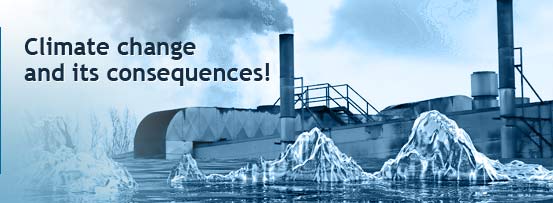|
|
| Never before has there been so much rain! |
Deluge - The weather has never been worse: Up to 70 liters per square meter in one hour. Why it rains so often, so hard, and with such bad consequences: The most important questions concerning the weather chaos.
Where do these torrential rains come from?
The very warm air has accumulated great amounts of water in the past few days. The air always contains water in the form of water vapour. The water vapour gets into the atmosphere when part of the water from oceans, lakes and rivers evaporates due to insolation. When the air saturated with water suddenly cools down, its capacity to absorb sinks. It rains. How hard it rains depends on by how many degrees the temperature has dropped. The consequences: heap clouds and severe thunderstorms.
Why do such cloudbursts occur so often?
Global warming intensifies thunderstorms, says Mojib Latif from the Max Planck Institute for Meteorology. For 100 years, the earth has been warming up continuously, especially due to the high consumption of fossil fuels. Due to the warming, the atmosphere can absorb more water vapour. Thus, the greenhouse effect is intensified. "And because there's more water in the atmosphere, the rainfalls become harder", says Latif. The Deutsche Wetterdienst (German Meteorological Service) is also recording an increasing number of extreme changes of weather from sweltering heat to severe thunderstorms. Their expert Hans-Joachim Heinemann explains that June and July have been about 1°C to 2°C warmer this year than the average. This is the reason for the fact that in this year almost the complete monthly average amount has fallen on a single day which brought up to 70 liters of rain.
Why are some districts or towns more affected than others?
An average of 30 to 35 liters of water per hour and square meter poured down on Hamburg and parts of Northern Germany. Blankenese and Finkenwerder reached maximum values of 65 liters each. "Statistically, this occurs in Hamburg only every 4600 years", says Matthias Sobottka, customer adviser of the local sewerage company. "Since the beginning of weather recording in 1960, we have never recorded such amounts of rain in one hour. Every region is affected at some time or other, noone can influence that", says Wolfgang Riecke, the Hamburg maritime weather office's climate and environment adviser. The consequences of heavy rainfalls decisively depend on the circumstances. Thus, the surface water can only drain away slowly. Furthermore, a dike had broken during the thunderstorm a few days ago.
Why are streets and basements flooded so often?
Due to the enormous water pressure in the sewers, manhole covers were busted from their holdings, basements and streets were flooded everywhere in the city. "Hamburg's sluice system is prepared for rains that statistically occur every five years", says Sobottka. Parts of the underground sewers are older than 150 years. But even the most modern of waste water systems can't cope with these amounts of water. "Especially in the city centre, where large parts of the ground are sealed, floods can occur easily." The local sewerage company wants to increase its cooperation with the building authorities in the future. Sobottka: "With new buildings, they often don't attach enough importance to rain drainage. Bottlenecks on and around buildings provide problems again and again." Ditches aren't always fit to drain water, too. Sobottka points out that the house owners themselves are often responsible for overflowing sewers: "Every house owner is obliged to protect his house against back pressure. Plumbers can install flaps and valves which of course have to be maintained."
Do we have to worry that such thunderstorms are becoming the norm?
"In the Future, we will have to expect such extreme thunderstorms more often", weather service expert Heinemann predicts. And the expert Latif warns: "If we continue to relieve these amounts of greenhouse gases into the atmosphere, the earth will warm up by about another 3°C (global average) in the next 100 years. In that case, he current weather threats would only be the first slight forebodings of what is to come."
When do we have to expect the next weather chaos?
If it is very hot and there's a new depression approaching, a new interface between a cold and a warm front can develop. Then, all requirements for a new cloudburst are met.
Please don't get us wrong! We don't want to "doom-monger" with these press comments, but it is definitely a fact that we have to expect more of these thunderstorms and cloudbursts which make flood protection even more important. In the future, we will have to deal with such weather events on a daily basis!
|
|
|
| |
|


